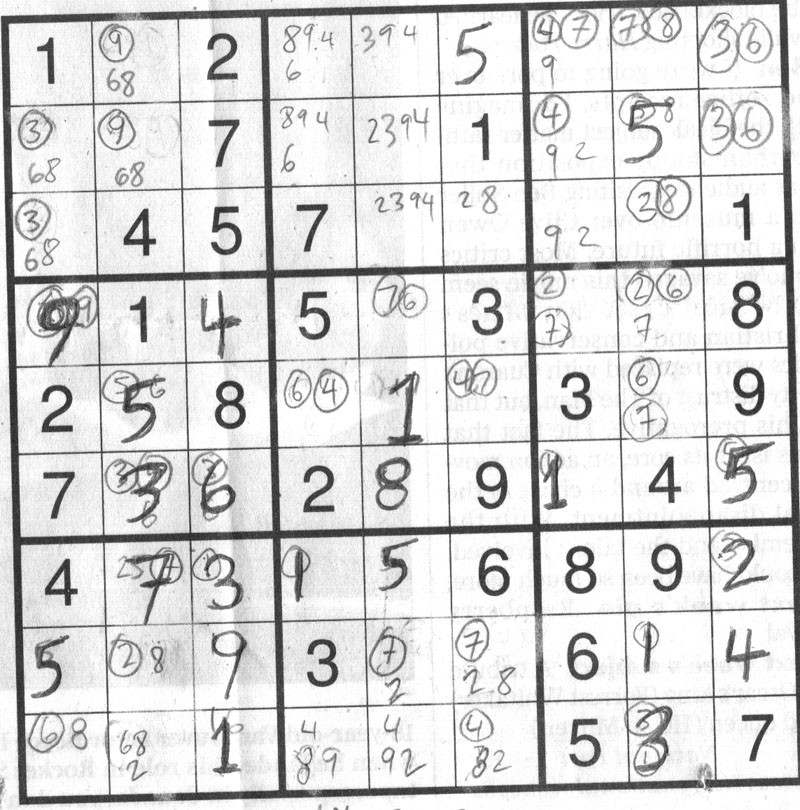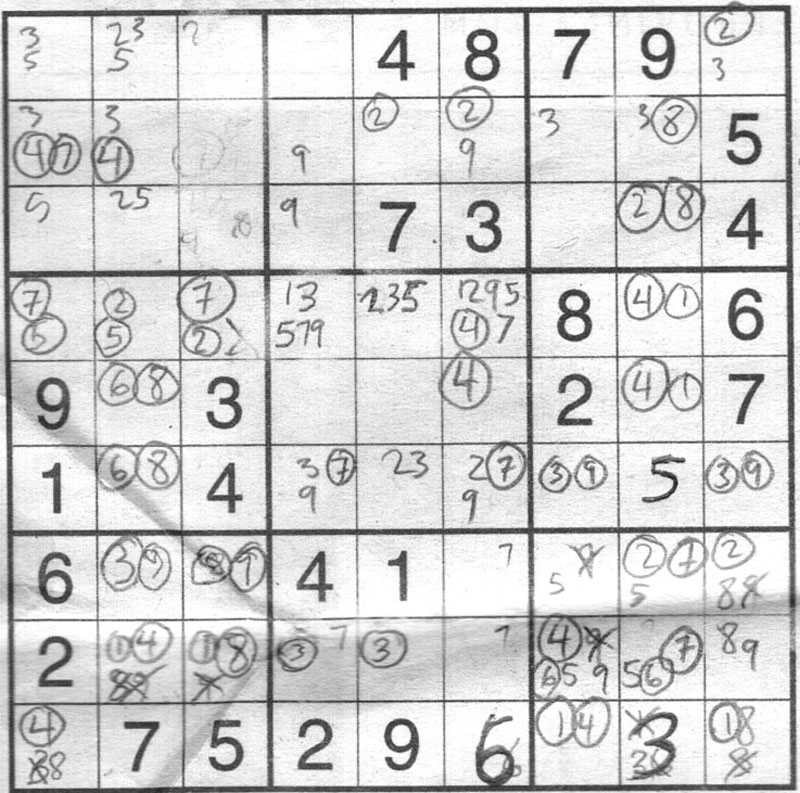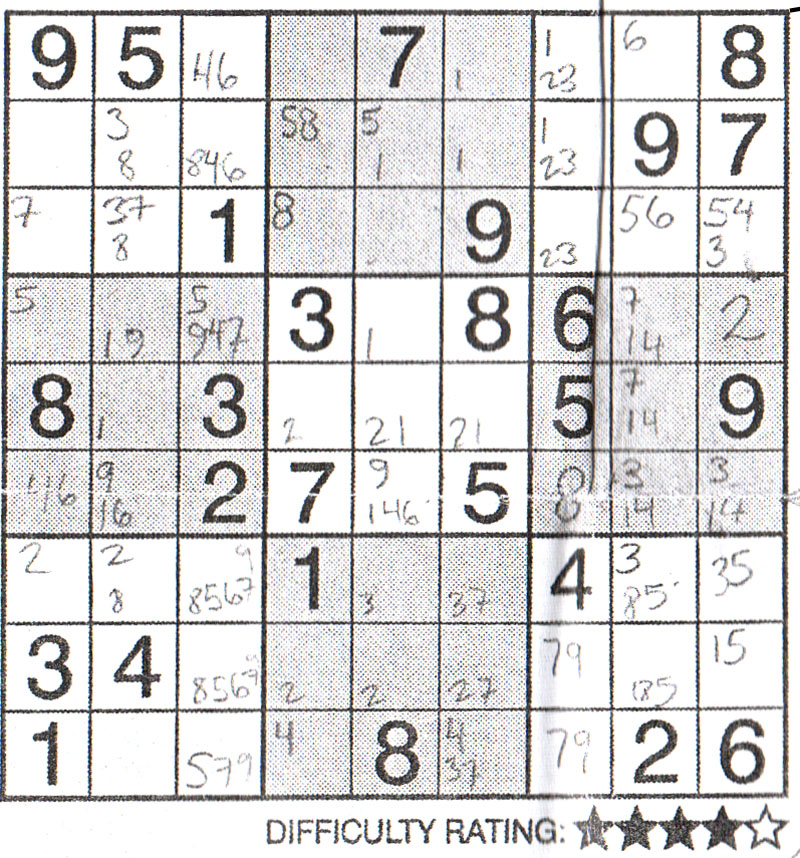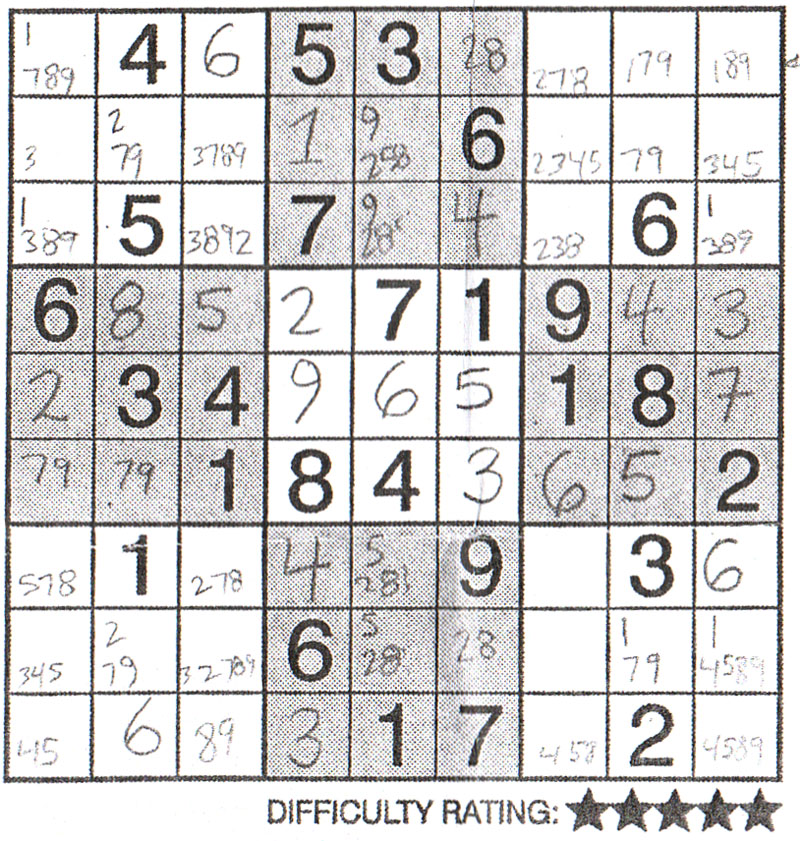| LESSON 6 | Candidates - Excluded | ||||||||||||||||||||||||||||||||||||||||||||||||||||||||||||||||||||||||||||||||||||||||||||||||||||||||||||||
| Ok, this is actually a special rule applying to candidates for the squares. Some web sites call this the excluded candidates rule because it is kind of like the triples rule where a set of known numbers can be eliminated from the others.
The rule goes something like this. If you have a set of 3 candidate lists which contains ALL the 3 candidate numbers across 3 squares within the same row, column or block. Sounds a lot like the triples rule we covered in Lesson 5 doesn't it? Now, it also works for set of 2,4, and even 5 squares too. Just finding them might be hard. |
|||||||||||||||||||||||||||||||||||||||||||||||||||||||||||||||||||||||||||||||||||||||||||||||||||||||||||||||
|
a. Basic |
Ok, so this doesn't look very nice. Lets look at the top row only. We only have one "7" and everything else are pencilled candidate lists. So these techniques really require accurate and updated lists so take care making them. I usually start with 1, but lets start from 9 working downwards.
Lets look at it more carefully. There are 3 squares, so we are looking for 3 candidates that show up in all 3 of these squares. Yes, 124 show up in all three, so it passes the first test. The second test is the 1 and 2 (and 4) must NOT show up anywhere else along this row. Yes, the 1 only shows up in these same three squares and the 2 only shows up in these same three squares; so it passes the second test. So according to the rule, the three digits 1,2,4 can ONLY be in these three squares. We don't know which of the three goes where but it can ONLY be in these three squares. So. With that information, we can eliminate all the other digits 3,5,6,7,8,9's from these three squares since there is no possibility for them to be here due to the triple.
Ok, we first remove all the extraneous candidates from the three 124 squares.
So the first block now looks like this:
But doing a quick rules test with the candidates quickly shows us that eliminating that "5" from the first square was all that was needed to solve square 4. Reason, there were 2 possible 5's in pencil 1245 and 45. But with the excluded candidates rule we got rid of one of the possibilities. Thus the ONLY place left for 5 to go is in the 45 by the block rule. So can PEN in the 5 (I'll do it in blue).
I will note, chain reactions are not always this obvious, but eliminating down your candidate list will go a long way to solving the really hard puzzles. |
||||||||||||||||||||||||||||||||||||||||||||||||||||||||||||||||||||||||||||||||||||||||||||||||||||||||||||||
| Examples |

24 Hr Newspaper, 8/18/2006 Column 5 : 239,39, 1279, 1237, 27. I see this as a pair 39 and a subset triple 127. So reducing, gives 39,39, 127, 127, 27. Now in the bottom block 8, we have 127, 138, 278, 28, 27. We notice that 3 only appears in one square, leaving 127, 278, 28, 27. We notice 1 is only in one place too so this reduces this down to 278,28, 27. By the way, if you spotted the triple 278 earlier you could have reduced block 8 as 1, 13, 278, 28, 27, which of course reduces to 1, 3, 278, 28, 27 which is what we arrived at. I now direct you to colunm 1: 4679, 69, 24679, 27, 247. Well, I am sure you thinking 69 or 27 as a pair. Well, 2 appears 3 times (24679, 27, 247), so you start thinking triple. Well, 247 would be the logical triple. Check the other 2 remaining squares (4679,69) for 2,4,7's. Well, that 4 and 7 shows up. So we see the are four 7's. So we probably can't do any combos using 7. So lets try the pair for 69. Well 6 appears (4679, 69,24679). Ok, looks like 694. Damn the 4 shows up in 247, so that is no good. Lets look the other way to block 2. We have 234, 239 (now reduced to 39), 29, 23489, 68, 39. Well we know that by pairs rule in the previous part that the 39 pair reduces the block to 24, 39, 29, 248, 68, 39. Well, 6 only shows up once so we can eliminate that one by PEN which will chain react and eliminate the 248 because that has the lone 8. Which precludes that the 24 has the onl 4 and that 29 has the only 2. Thus the only thing left in that block is the 39 pair combo we started with. I now direct your attention to column 7: 239, 69, 369, 239 (we can erase the 3 now). Ok, I know you are thinking the excluded candidates or pairs rule for sure. Lets see. I know you are thinking, 69 but 9 appears in the other 2 squares so no excluded candidate rule. Same reason for 23, and 29. So lets try a triple 239, same problem that 9 shows up in all of them. So although it looks obvious, there is nothing there, at least for now. Now, you at this point you really don't need anymore fancy rules, since the puzzle now is solvable using basic lesson 1 rules. |
||||||||||||||||||||||||||||||||||||||||||||||||||||||||||||||||||||||||||||||||||||||||||||||||||||||||||||||

I direct your attention to block 8. You can see 5 candidate sets: (19, 25, 15,139, 235). Now you want to be thinking can I split this 2/3. You can see there are two locked pairs 19 and 15. I will look into locking pair 19 as a pair, and make 235 the triple. Well, by looking at column 5 it is obvious 9 must be in cell 8 and there are only 2 of them. Thus the second pairing digit must be 1. 1 only shows up with 9 twice and once with 5. So that is 2 candiates in 2 cells, we can lock the paired set in those cells. Thus if we made a 19/235 split, the form will simplify to (19,25,5,19,235). |
|||||||||||||||||||||||||||||||||||||||||||||||||||||||||||||||||||||||||||||||||||||||||||||||||||||||||||||||
| Examples |

From the National Post. I will direct your attention to column 3. You have 15,25,294,294,19 as your candidates. Lets try and divide it into a paired/triple split. Well, it is obvious that 5 never appears with 9 so 5 will be on one side of the split and 9 will be on the other. We also see that 4 is never with 5 either. Thus 4 will be the 9 set. Well, from this it is pretty plain to see that the triple must be 294 since 2 of them are staring right in front of us. Thus the pair must be 15. We now simplify, we end up with 15,5,294,294,9. Continue to do the chain reactions and the rest of the puzzle is easy. |
||||||||||||||||||||||||||||||||||||||||||||||||||||||||||||||||||||||||||||||||||||||||||||||||||||||||||||||
| Examples |

From National Post Jan 22, 2007 Look at Row 9. We have the candidates 68,268,489,249,284. Lets try and group them into a 2/3 split. Well, we can see that 6 never appears with 9. Same can be said with 4. Thus it is the 2 and 8 that flip. Well, if you pick 2, it doesn't pair up with 6 as well as 8 does, since it makes up a locked pair and you eliminating less 8's. So we will make the split 68/249, thus simplifying it to 68,68, 49,249,24. This doesn't do a heck of lot in row 9 but you can see that now we have a locked pair in block 7 which will reduce the 28 down to 2. Thus the chain reaction starts. |
||||||||||||||||||||||||||||||||||||||||||||||||||||||||||||||||||||||||||||||||||||||||||||||||||||||||||||||
| Examples |

From National Post Dec 31, 2006 Look at Row 5. We have 9327 as known. We have 68 already locked down and 14 can not be part of 68 since 14 is in the same block as the 68. Well that makes things really easy. We just have to figure out the last candidate which is 5. Again, that is pretty obvious since 68 is locked down in block 4, that means the 5 can't be with the 68 (making 685/41 combo) so it must go with the 14 (making the 68/145 combo). Note I have 2 empty cells in row 5 which have no candidates written in them. Well, now we know that the combo is 68/145 we can fill it in. We note that the 68 in block 6 and the squeeze by 9134 in block 4 means 68 is locked in column 2. Thus the 5 must be in row 4. Therefore in block 5, the 5 must be in row 5, thus making our candidates 68, 5, 5, 54, 14. One can aappear in 2 places so I will fill them in. 68, 15, 5, 145, 14. Six can only appear in 2 spots, thus making 68, 615, 56, 145, 14. The 8 only goes in 2 spots, making 68, 6815, 685, 145, 14. So which of the 6815 or 685 belongs to the 68 pair and which one goes with the 145 triple? Well, 5 is free floating due to the locked 68 pair which leaves the 1 which comes from the locked 14 combo down in block 6. So it is important that the 1 stays with the 4 and thus the 5, thus your combo will look like 68,15,68,145,14. |
||||||||||||||||||||||||||||||||||||||||||||||||||||||||||||||||||||||||||||||||||||||||||||||||||||||||||||||
| Examples |
 I will draw your attention to Block 3. We have a 176, a 4 we solved, a 56 in the centre and a 179, 56 and 179 in the last row. Again, we notice certain numbers are locked. The 5 can only be in column 8. We see that 5 is independant of 179 and only ever shows up with the 6. So we can make a 179/56 split combo which will reduce things down to 17,56,179,56,179. |
||||||||||||||||||||||||||||||||||||||||||||||||||||||||||||||||||||||||||||||||||||||||||||||||||||||||||||||
| Examples |
 then solves to then solves to  I will draw your attention to the 6th row. You have 46. 196, 1496, 314, and 314. It is obvious that 96 is independant from 3. Now what about the 4 and the 1? Well, the first block shows that 4 can only be with 6, so we put the 4 with 96 and we put the 1 with 3 makinga 469/13 split. This will dreduce the line to 46, 69, 469, 13, 13. The second step that you must realize is that cell 9 in block 8 can be simplified. It has 347 as the candiates, now with some chain reactions, you should be able to deduce that only 3 can go here. |
||||||||||||||||||||||||||||||||||||||||||||||||||||||||||||||||||||||||||||||||||||||||||||||||||||||||||||||
| Examples |
 So directly after doing your initial criss-cross, you will see a rather obvious 2/3 split. I will direct your attention to column 6. We have 38,5613,5613, 13, 68. You can quickly see that both 1 and 5 never appear with an 8. So it becomes a choice between which way the 3 or 6 go. If it goes 38/156 then you get 38, 156, 156, 1, 8 which seems a bit of stretch to eliminate 2 squares like that. Not to say it can never happen, but I would think it is a lot less likely. So I will take the other route and do a 68/153 split. This yields 8, 153, 153, 13, 68. You can see that the 13 is a locked pair which is also a good indicator that the 3 was ment to be with the 15 combo. Now with the 8 and 6 solved, this should make the puzzle easy enough to solve by regular means. |
||||||||||||||||||||||||||||||||||||||||||||||||||||||||||||||||||||||||||||||||||||||||||||||||||||||||||||||
| Examples |
 This puzzle is a bit tricky but nothing that you haven't learned. First, look at the top row: 1789, 28, 278, 179, and 189. Well it is obvious that 2 and 9 are exclusive to each other we know it is split 2/9. 28 is locked so we can make it 28/9 leaving only the 1 and 7. 1 is also exclusive to 2 so we put that on the 9 side making 28/19 leaving a 7. If you put the 7 on the 278 side making 278/19, you end up with 78,28,28 and 19, 19 which is kinda whacked although saying that it is not impossible, but I strongly think it is unlikely. So I choose to do it the other way, and put the 7 on the 179 side making the split at 28. This will simplify the candidates in row 1 to 179,28,28,179,19. This in turn makes 45 a paired set, thus solving for the 3. The chain reaction continues as you solve for a 2 and then an 8. Next column you should look at is column 3. We have 3789, 3892, 278, 32789,and 89. Ok, we can do 89 as the base since it is a locked pair. Now. that leaves 23 and 7. Look for the 289/37 split on this row and then the rest of puzzle it will be easier. |
||||||||||||||||||||||||||||||||||||||||||||||||||||||||||||||||||||||||||||||||||||||||||||||||||||||||||||||
| Examples
Hint |
 Hint: use a 45/329 combo on column 5. |
||||||||||||||||||||||||||||||||||||||||||||||||||||||||||||||||||||||||||||||||||||||||||||||||||||||||||||||
| Examples
Hint |
 Hint: use a 24/137 combo on the 2nd column. |
Written by William Chow